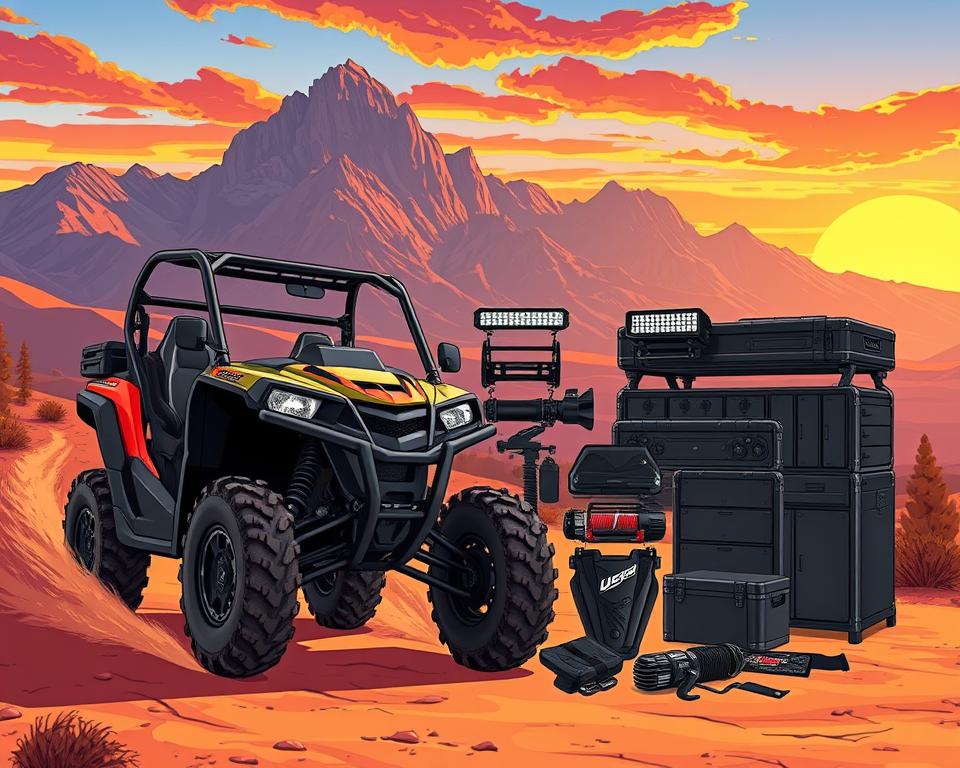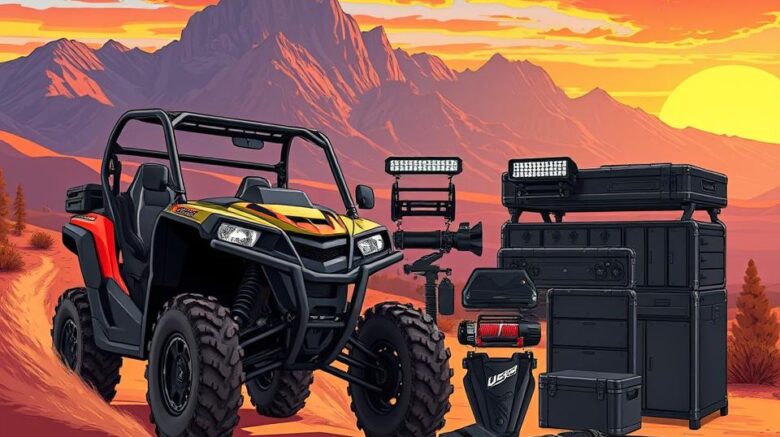Complete ATV Off-Road Safety Prep Guide
Did you realize nearly 450,000 ATV-related injuries are treated in U.S. emergency rooms each year? That startling statistic underscores why off-road safety and preparation are essential. The Essential ATV Off-Road Checklist is your guide to a safe and enjoyable ride. It covers everything from rocky trails to sand dunes. Armed with proper safety equipment and can-am commander upper doors must-haves, you’ll reduce hazards and amplify the fun.
Central Ideas
- Prioritize safety by using the Essential ATV Off-Road Checklist for optimal preparation.
- Don’t hit the trail without this ATV safety gear list.
- Maintenance matters: check often, ride better.
- Stay fueled and hydrated for peak performance.
- Master your GPS and maps to stay on track.
- Weather can flip fast—be ready with proper gear.
- Always carry essential tools and recovery kits for on-trail repairs and emergencies.
Understanding the Importance of Safety Gear
Safety is non-negotiable for every off-road trip. The excitement of ATVs brings potential hazards. Proper gear guards you against mishaps. Gear up correctly with this ATV safety gear checklist.

Essential Protective Gear
Maximizing protection involves several key items:
- Riding Helmets: Choose DOT-approved helmets to prevent head injuries.
- Goggles: Protect your vision with wraparound goggles.
- Riding Gloves: Wear durable gloves for better grip and hand protection.
- Footwear: Wear sturdy boots that cover the ankles to prevent injuries.
- Protective Armor: Chest and back armor add vital protection.
- Neck Braces: Support your neck to prevent serious injury.
Emergency Preparedness
Don’t overlook your emergency kit. A well-packed kit might save your life. Key items to include are:
- First aid kit
- Multi-tool
- Tire repair kits
- Portable air compressors
- Emergency blankets
- Whistles
- Matches
ATV Equipment for Optimal Performance
The right kit makes all the difference. Don’t leave home without these ATV must-haves. Use this maintenance checklist to keep your ride healthy.
Must-Have ATV Equipment
- Durable Tires: Invest in tires designed for various terrains to improve traction and handling.
- Cargo Systems: Use efficient storage compartments for tools and emergency supplies, ensuring quick access when needed.
- Fuel Reservoir: Opt for a robust tank to avoid drips and dry runs.
- First Aid Kit: Prepare for emergencies with a well-stocked first aid kit for immediate attention if needed.
Regular Maintenance for Longevity
Routine care keeps breakdowns at bay. Regular inspections should encompass:
- Inspect and clean or replace air filters regularly.
- A well-lubed chain spins quietly and reliably.
- Test your brakes on every pre-ride check.
Stay on top of upkeep and your ATV will perform its best.
The Essential ATV Off-Road Checklist
Preparing for a ride is more than just hopping on your ATV. A quick check prevents major headaches. Every point matters—don’t rush. A little prep goes a long way.
Pre-Ride Inspection Basics
Before any off-road journey, a pre-ride inspection is vital. Catch faults early with a fast inspection. Key elements to check include:
- Tire pressure and tread condition
- Fluid levels such as oil and fuel
- Brakes and controls functionality
- Operational lights and horn
- Chain or driveshaft integrity
T-CLOC Inspection Method
Use T-CLOC for a thorough pre-ride check. Five key areas: T-CLOC ensures all are inspected. This method ensures all critical areas are covered:
| Inspection Area | Checklist Items |
|---|---|
| Tires and Wheels | Check tire pressure, inspect tread depth, look for damage |
| Controls | Test brakes, throttle, and clutch for smooth operation |
| Lights | Ensure headlights, brake lights, and indicators are functioning |
| Oil and Fuel | Check oil level, inspect for leaks, and fill fuel tank |
| Chain/Driveshaft | Examine for wear, proper tension, and lubrication |
Check everything—ride with confidence. Prevent roadside repairs with a fast check.
Hydration and Nutrition for Long Rides
Long ATV rides require careful attention to hydration and nutrition. Riders often underestimate their fluid needs, making it essential to plan ahead. Water packs help maintain endurance and alertness. Nutritious snacks power you through rough stretches.
Importance of Staying Hydrated
Drink often—don’t wait for thirst. It’s important to drink water consistently, not just when thirsty. Backpack reservoirs keep water flowing hands-free.
High-Energy Snacks to Pack
The right fuel makes the ride smoother. Pack portable, long-shelf treats. Some ideal choices include:
- Protein bars
- Nut mixes
- Dried fruits
- Beef jerky
Snack smart for sustained energy. Mix sweet and salty options for flavor and function.
Navigation Tools for Off-Roading Adventures
Stay on course with proven navigation aids. Off-road navigation tools are invaluable for staying on track, no matter the terrain.
Advanced GPS Systems
An advanced GPS system is a must for off-road adventures. Choose units with rugged builds, offline charts, and extended runtime. Brands like Garmin and TomTom offer models designed for off-road use, ensuring durability and precision.
Traditional Navigation Aids
Technology is key, but traditional tools are also essential. Maps won’t die when batteries do. Wind your own way with map and compass skills. Tech plus tools equals total navigation readiness.
Communication Equipment for Safety
Effective communication is key during off-road adventures, as many trails are in remote areas with no cell service. Clear comms keep your group coordinated. Knowing you can call for help reduces stress.
Group rides need reliable radios. These devices ensure clear audio over long distances. Stay informed of detours or emergencies instantly. When choosing two-way radios, look for models with:
- Rugged, waterproof design to resist the elements
- Long battery life for extended trips without needing a recharge
- Channel selection for clear communication without interference
No ride is complete without radios. Group comms save time and reduce risk. Radios cut through noise and barriers. Stay connected, stay safe.
Self-Rescue Gear for ATV Riders
Self-rescue gear is as vital as your helmet. Self-rescue gear for ATVs is key to handling challenges on your own. Being self-sufficient elevates confidence and safety.
Winches and Recovery Kits
Winches are vital for self-rescue, helping pull your ATV from tough spots. A winch paired with a detailed ATV recovery kit is even more effective. Recovery kits usually include:
- Tow straps
- D-rings
- Recovery boards
- Gloves
Practice recovery techniques before you need them. Be ready for anything the trail throws at you.
Trail Recovery Essentials
Your toolbox should extend beyond the winch. These include:
| Equipment | Purpose |
|---|---|
| Recovery Straps | Used for towing or pulling ATVs out of tight situations. |
| Shovel | Helps clear obstacles and dig out vehicles when stuck. |
| Traction Mats | Provides grip under tires in muddy or slick conditions. |
| Portable Air Compressor | Enables quick tire inflation after deflating for better traction. |
Don’t rely on luck—bring the right tools. Knowing how to use these tools greatly improves safety and adventure on your off-road excursions.
Staying Adaptable: Preparing for Weather Changes
Expect the unexpected in the outdoors. It’s vital to be ready for sudden changes to stay safe and enjoy the ride. Don’t forget your layers and rain shell.
Layer up, shed as needed. Start with wick-away fabrics. Fleece or wool gives you warmth on demand. Finish with a rain-and-wind jacket. This setup ensures you stay comfortable, no matter the weather.
Weather-Appropriate Clothing
- Rain Shells: Essential for keeping dry during unexpected rain showers.
- Ventilated Off-Road Pants: Pants that vent yet keep out the rain.
- Sun Protection: Lightweight, long-sleeved shirts and wide-brimmed hats safeguard against harmful UV rays.
- Insulated Gloves: Warm gloves maintain dexterity in chill.
Gear up for every climate challenge. Stay focused on the trail, not on being wet or cold.
Tools for On-Trail Repairs
Having the right tools for on-trail repairs is key to a safe and enjoyable off-roading experience. Don’t skimp on repair gear. These tools help address minor breakdowns or issues that may arise during your adventure.
Must-Have Tools and Kits
A well-prepared rider should assemble a basic tool kit. This kit should include essential items for quick repairs. Critical ATV repair tools might include:
- Tire irons for changing flat tires
- Pliers for gripping and cutting
- Wrenches for various sizes of bolts and nuts
- A multi-tool for versatility
- Spare items such as spark plugs and electrical wire
- Duct tape for quick fixes
Having these tools readily available boosts confidence and autonomy while exploring off-road trails.
Basic Emergency Supplies
In addition to essential tools, packing basic emergency supplies for ATV is vital. These supplies help ensure your safety in challenging situations:
- First aid kit for injuries
- Flashlight with extra batteries for night-time visibility
- Emergency whistle for signaling assistance
- Reflective triangles or flares to warn other riders
- Water and high-energy snacks for sustenance
Preparedness significantly impacts your off-roading experience. Your safety net on the trail.
Conclusion
Well-planned rides are the best rides. Check off each item and pick reputable brands. Be set for rocks, sand, mud—anything.
Gear up fully and ride securely. Prep wisely for peak thrills and protection. Embrace excitement, ditch the doubts.
Stay ready, ride with care, and enjoy the unforgettable moments off-roading offers. The journey is as important as the destination. Use this guide for the best off-road experiences.
FAQ
What belongs on an ATV gear list?
Start with a DOT helmet and sturdy goggles. Gloves, suitable footwear, and body armor are also necessary. Neck braces help guard your spine. Also bring a medical kit and adaptable multi-tool.
How can I ensure my ATV is well-maintained?
Inspect air filters and grease the chain often. Inspect brakes as well. Regular service keeps your ATV trail-ready.
What is included in T-CLOC?
The T-CLOC inspection method covers several key areas. Cover Tires, Controls, Lights, Oil/Fuel, Chain in T-CLOC. This ensures your ATV’s critical components are in working order before hitting the trails.
Recommended hydration levels for trail rides?
Carrying more water than you think you’ll need is essential. Proper hydration wards off exhaustion. Use a hydration bladder for quick sips.
How to stay on course off-road?
For navigation, invest in an advanced GPS system designed for off-road use. Combine this with traditional aids like waterproof maps and compasses.
Role of radios on the trail?
Radios prevent isolation when cell fails. Areas with limited cell service highlight the need for reliable two-way radios.
Essential recovery gear for off-road?
Be ready with winch and recovery essentials. Have straps, shackles, mats, and gloves on hand.
Tips for weather readiness off-road?
Layer up and down as conditions shift. Pack a rain shell to stay dry. Sun protection is also critical to prevent UV exposure.
Which trailside tools matter most?
For on-trail repairs, pack a basic tool kit for minor fixes. Don’t forget duct tape and electrical wire.
